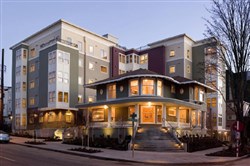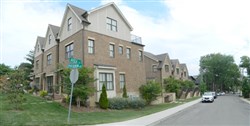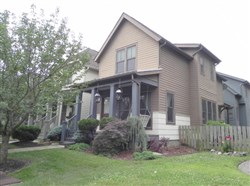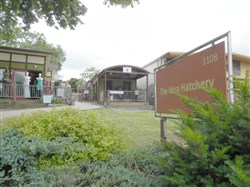VOL. 38 | NO. 24 | Friday, June 13, 2014
Homebuyers pay the price for Nashville's 'It City' status
By Jeannie Naujeck
From the national press, one might think Nashvillians’ main concern these days is what new gastropub to try or which A-lister is playing a secret show at Third Man Records.
But eavesdrop at any coffee shop, bar or restaurant where locals gather and you’ll hear a different story.
Sure, people are amused by the hype. But they’re more worried about its effects on the city, and whether they’ll be able to live in once-affordable neighborhoods.
Housing affordability is the talk of the town, and it’s only getting louder as the term – once used only when speaking in the context of the truly poor – enters the lexicon of professionals who have long believed they could live well in Nashville on a middle-income salary.
At work is the law of supply and demand.
Nashville-Davidson County is seeing the first waves of up to 200,000 people who will move here by 2040 [one million for Middle Tennessee’s 10 counties]. The Nashville newcomers and the city’s developers have been snapping up properties in neighborhoods that were once the province of everyday people.
The resulting home-price escalation is one of the biggest challenges facing a city that’s long prided itself for its low cost of living and high quality of life.

Johnson
“I’m always optimistic about Nashville. We have a lot of great people and decision-makers that tend to be able to figure these challenges out,” says Paul Johnson, executive director of The Housing Fund, a private, non-profit organization that helps finance affordable housing and neighborhood redevelopment projects throughout Middle Tennessee.
“But this is a big one. If we don’t solve the affordable housing issue – and by affordable housing I do not mean housing for just poor people – I don’t think we’re going to have those 200,000 people moving to our city.
“They’ll pick up and go to another community that has the lifestyle, amenities and affordability that they’re looking for. That’s why they’re coming here, right?”
‘Suburbanization of poverty’
As the population increases, Nashville will need 113,000 new homes by 2040 to accommodate growth, a background report prepared for NashvilleNext reveals. That’s 3,800 new housing units per year in a county where more than half the land is currently zoned for single-family homes.
Up to 75 percent of future housing needs will be for rentals, which is why developers are taking urban land lots off the market.

Claxton
If development proceeds along the current path, residents of moderate income will be pushed out of the city, says Metro planner Greg Claxton, who is overseeing the rollout of three future growth scenarios that will be presented to the public for input in a series of open meetings starting June 16 and running through the fall. (See page 8)
“One of the big stories that we’ve been hearing from the public, that people are concerned about, that we see happening, and that we expect to happen more without some change in direction is this sort of split – gentrification and the suburbanization of poverty,” Claxton says.
“If trends continue, with more development downtown and near downtown, we would expect to continue to see increasingly wealthier households (in the city), and poor and moderate income folks locating to the edge of the county or even other counties.”
To accommodate the growth, Nashville must increase housing density to accommodate them. Where and how to do that is the focus of the upcoming growth scenarios.
Public policy crucial
But another big question is how to keep the city welcoming to everyday people.
Affordability is the top concern of Nashvillians from all walks of life – and that’s not just based on anecdotes overheard in coffee shops. Some 9,000 Nashvillians consistently ranked “affordable living” as the city’s top priority – followed by transit – in public surveys and workshops hosted by the Metro Planning Commission as part of NashvilleNext, an effort currently underway to plan for growth and development for the next 25 years.
That held true regardless of which demographic category they fell under – gender, age, race, education level, neighborhood of residence, or length of time living in Nashville.

Fraser
“The bottom line is it’s going to have to take public policy at the municipal level for us to maintain and build more affordable housing. The private sector is geared toward making a profit,” says James Fraser, associate professor at Vanderbilt’s Peabody College, who studies urban environment, revitalization and public policy.
“In a society where private ownership of land is a central principle, we have to take a certain amount of property out of the private sector, put it in the public sector and develop a larger portfolio of social housing.
“That can be everything from building more public housing for very low-income people to building moderate income housing and having programs in place to help families of moderate income get into homeownership.”
‘Cost burdened’
Housing is becoming less affordable for even educated professionals.
The salary for a Metro public school teacher with a master’s degree and 10 years’ experience was less than $50,000 during the past school year, and many of the city’s musicians and songwriters live below the poverty level.
There is a waiting list for the 60 units at Ryman Lofts at Rolling Mill Hill, which opened last year as Nashville’s first housing development for low-income artists.
The average median income (AMI) for the Nashville-Davidson County Metro area in 2014 is $44,800 for a single person, $51,200 for a household of two and $64,000 for a household of four, according to the federal Department of Housing and Urban Development, which estimates the AMI for use each year in determining affordability standards.
About a third of homeowners and half of renters in Davidson County are considered “cost-burdened,” meaning they spend more than 30 percent of their income on mortgage or rent. That doesn’t include transportation, on which the average Nashville resident spends 20 percent of his income. And one in five households live in poverty.
As more affluent people move back to cities – a reurbanization trend being seen across the country – those numbers are likely to rise.
Nashville is one of the top cities for attracting young people with degrees, yet many start out with salaries that qualify them for affordable housing units.
“I think the real challenge with the new folks that are going to be coming in, as much as the pressure that they’re going to place on existing neighborhoods, is matching their incomes to the housing that is available,” Johnson says.
“And if these are folks that are coming to fill a lot of the new service industry jobs that we’re creating, there’s a big percentage of that 200,000 [new residents] that is going to need affordable housing – and the existing inventory of affordable housing, even absent gentrification, isn’t going to meet those needs.’’
“So I think finding ways to develop new middle-income to lower-income housing, looking at that kind of bundle of incentives and subsidies is going to be very critical over the next couple of years.
“Middle-income families and workforce housing, not just housing for lower income families, are increasingly being displaced and impacted by gentrification,’’ Johnson adds.
“I think in some of those cases it’s looking at what some of our development policies are, and how we incentivize developers to do housing for all of the different income ranges. That may not be a subsidy. That may be a land-use policy or a zoning policy or some other type of public policy.”
Seattle sets standard
Nashville might look to Seattle for ideas.

Seattle’s Pantages Apartments are among sever residential buuildings funded through the Seattle Housing Levy, a property tax earmarked for affordable housing programs.
-- Photo Courtesy Of City Of Seattle Office Of HousingThe two cities have more in common than hot economies and hyped-up music scenes. Seattle’s emergence into the national spotlight began 25 years ago, and the city has seen population growth, development and rising home prices ever since.
The City of Seattle has roughly the same population as Nashville, according to Census estimates. Both cities have agencies that manage roughly the same number of public housing units for very low-income residents.
Yet, Seattle also has an Office of Housing that funds a variety of affordability programs aimed at helping moderate-income households with rent and homeownership. It is funded through a property tax that voters have approved each time it’s come up since 1981.
The need for affordable living assistance in Seattle is acute. The area’s median income is $88,200 for a four-person household, while the single-family median home in King County [where Seattle is located] last year was $415,000.
Through its Office of Housing, the city has enacted a number of regulatory and funding mechanisms to create more housing units and assist with down payments. They include:
- Tax exemptions for developers who reserve a certain number of “affordable” units for purchase by households with incomes of up to 100 percent of AMI
- Down payment assistance of up to $60,000
- A community land trust program that removes the cost of the land from a home purchase (allowing the homebuyer to purchase only the house it stands on in exchange for transferring equity).
Much of the funding comes from the Seattle Housing Levy, a property tax specifically earmarked for affordable housing. In 1981, Seattle became one of the first major cities to enact the tax when voters approved a bond levy. Since then, they have affirmed the levy four times, each one for a period of seven years.
The 2009-2016 levy will provide a total of $145 million – or $20.7 million each year – or about 45 percent of the money distributed by the Office of Housing, meaning it doesn’t have to rely as heavily on other sources such as federal grants for a sustainable flow of money. And properties funded with levy money must remain affordable for at least 50 years.
Resale restrictions
Where many cities’ housing assistance programs fall short is in sustaining them over the long haul.
Some tools are better than others for creating a long-term affordability strategy. The tax breaks that Nashville offers to developers for building “affordable” condo units are a good example of what is not sustainable.
During the recession, many condominium developers took advantage of the tax incentive, called tax increment financing (TIF), which requires that 20 percent of units be offered as “affordable” in their projects.
Affordable units – generally small studio or one-bedroom condos costing up to about $150,000 – were included in high-profile developments such as the Viridian, the ICON, Encore, The Kress and Werthan Mills, among others. Purchasers had to make less than 80 percent of AMI – or about $36,000 – to qualify.
TIF did help the city achieve its goal of encouraging infill development and downtown living. But the affordable aspect was short-lived.
Resale restrictions only lasted five to seven years, and some early buyers who purchased the affordable units five years ago sold them once the restriction expired and reaped around $50,000 in profits.
In contrast, the concept of shared equity housing keeps homes affordable forever. Aimed at helping moderate-income homebuyers, shared equity programs provide funds equaling about 25 percent of a home’s value, creating automatic equity (effectively, a lower sale price) that allows for a smaller mortgage and down payment.
The key feature of shared equity is that the home is permanently resale-restricted. That means when the buyer sells the house, he or she gets a portion of the appreciated value but the original 25 percent investment, plus the remaining appreciation, conveys forever, keeping the home affordable for future owners.
The programs are generally available to people with incomes of up to 120 percent of AMI – in Nashville, that would include single persons making up to $53,760 or a four-person household making $76,800. The Housing Fund launched a shared-equity program in 2010.
“It’s one of the most exciting things that has happened in Nashville,” Vanderbilt’s Fraser says. “It’s fairly new to Nashville but if shared equity housing was expanded it would help a lot of moderate-income families.”
The Barnes Fund
Another positive development was Mayor Karl Dean’s announcement last May that the city was establishing an affordable housing trust fund with the goal of funding 100 new affordable housing units each year, and making another 200 units more affordable.
Named after Methodist minister and social activist Bill Barnes, the Barnes Fund for Affordable Housing is one of some 700 such trust funds nationwide.
Housing trust funds provide funds to non-profit housing developers to build housing for people within certain income guidelines. What makes them powerful is that the money allocated to it by the city can be leveraged to secure additional federal and private development funds.
The housing trust fund that Minneapolis established in 2002 has helped the city build or renovate more than 6,100 affordable and mixed-income housing units between 2003 and 2012.
Each $1 allocated to the trust fund generally attracts about $9 of additional public and private funds. The result: the housing trust fund’s total $73 million investment has been matched by an additional $777 million to fund $850 million worth of affordable housing. Minneapolis successfully used new developments to help revitalize blighted neighborhoods and attract business development, as well as increase housing density along underutilized corridors.
The city began its fund with the goal of allocating $10 million annually, but has fallen short in most years as federal monies for the program have declined. This year the Minneapolis City Council approved an additional $1.5 million over what the mayor had proposed, for a total appropriation of $7.7 million.
Nashville’s Barnes Fund was originally capitalized with federal funds totaling more than $3 million. For the 2014-2015 budget, Mayor Dean has recommended that $500,000 from the city’s general fund go to the Barnes Fund – the first time general fund revenues have been proposed for that purpose.
Dean anticipates the Metropolitan Development and Housing Agency will leverage another $1 million toward Barnes-related projects in the next funding round, spokeswoman Bonna Johnson says.
‘Do we have the political will?’
Fraser says simply having a housing trust fund is a start, but the city must now find a way to sustain it.
“Right now, Nashville is very unaffordable for low-income families to live near the central core,” he explains.
“To provide opportunities for people to do that, we need to fund things like the housing trust fund at a much higher level and really take it seriously. There has to be dedicated streams of money, and there are plenty of mechanisms to do that, like development fees.
“The question is, do we have the political will? It’s got to be something the City Council can get behind.”
The Metro Council recently approved a resolution allocating $2 million from the Barnes Fund for four new affordable housing developments for very low-income and special needs people. All are in North Nashville and all are targeted to Nashville residents making 50 percent or less of AMI – $22,400 and under.
One is a 20-unit complex along Clarksville Pike with studio, one- and two-bedroom apartments, including four set aside for people with HIV/AIDS. The 4.75 acre lot is currently blighted, with a burned-out building that has been a constant source of trouble for the police department; more development is planned on the lot in the future.
Two other multi-unit developments will have three- and four- bedroom units for low-income families, an area of high demand and low supply. The fourth project is two large homes that will house elderly and disabled people in a communal setting.
Along with providing housing, the developments further another city goal – revitalizing neighborhoods by converting vacant lots and dilapidated structures into attractive, high-quality structures that will attract private-business investment.
Neighborhood Stabilization
Before the Barnes Fund, Nashville had already started to build a portfolio of income-qualified buildings, some built along “green” or LEED principles, in zones targeted for redevelopment.
Rolling Mill Hill, in addition to expensive privately-developed condo and apartment buildings, also has two city-funded buildings aimed at low-income workers and artists: Nance Place Apartments and Ryman Lofts.
Nance Place opened three years ago as a 109 unit “affordable housing” complex with units starting at $646 for a 500 square foot studio and going up to $919 for a three bedroom apartment. An individual wanting to rent a studio can make no more than 60 percent of AMI, or $26,880. And The Ryman Lofts opened last year, designated specifically for artists with the same income constraints.
On Dickerson Road, MDHA used federal Neighborhood Stabilization Program (NSP) funding to build Uptown Flats, another workforce housing building with 72 one-to-three bedroom apartments. Projects funded with NSP money can be offered to residents at up to 120 percent of AMI.
The developments are a start. But the challenge is acquiring land in a hot market and dedicating enough funds to subsidize development.
For all the good that Minneapolis’ housing trust fund has done, the city still has a severe affordable housing shortage, with 10,000 people facing years-long waits for public housing. Minneapolis is experiencing an urban renaissance too, and land parcels are being snapped up for high-end development.
Priced out of the neighborhood
But not everyone in the “moderate” income range – where many Nashville professionals, artists and musicians, public and service workers and young people fall – wants to live in a subsidized apartment or one of the “micro-units” that private developers are proposing to build downtown.

Homes like these in the urban core near Centennial Park blend in with existing structures and are built with affordability in mind. These units were designed by Keith Covington, a former Metro planner and now part of Third Coast Design Studio. Young families too often “…can’t afford to buy one of these older houses and fix them up because they’re too expensive. Or the ones that are infill are too expensive,” Covington says.
-- Leigh Singleton | Nashville Ledger“We have to have choices,” says Keith Covington, Third Coast Design Studio architect with and former Metro planner.
“From a planner, urban designer perspective, housing choice is critical. And what is the answer for affordability – I mean affordable to everyday folks who maybe aren’t earning six figures a year?”
Covington understands the issue. He lived in the Richland-West End area for about 10 years, renovating a house he then sold during the recession. Now, he wouldn’t be able to get back in.
“We basically priced ourselves out of the neighborhood. You’ve got to be like a millionaire now. And that’s really hard because there’s a lot of people that want to be in these urban neighborhoods, and they’re having trouble getting into them,” Covington says.
“For young families who want to be in these vibrant areas, they can’t afford to buy one of these older houses and fix them up because they’re too expensive. Or the ones that are infill are too expensive.”
Bungalow courts, carriage houses
In fact, a variety of zoning changes are being considered that would increase density in neighborhoods while maintaining character – an important factor for current residents.
“Part of it is regulating – what can people build, what can people remodel. The other side is, what do we spend money on?” says Metro Zoning’s Claxton.
“There are plenty of folks for whom affordability is the key attraction of Nashville, affordability and having a job available. Certainly, how we grow has an impact, the tax base, what kind of units we allow. But there’s always going be a role for low income needs that aren’t being met by the private market; moderate income needs, how do we get the market to head that way?
“So right now what we’re doing alongside these is rolling out some goals and policies that say, what’s the policy side that has to fit with this,’’ Claxton explains. “And affordability and neighborhood character – both of these are big parts of it.’’
Policy ideas include encouraging homeowners to build an accessory dwelling unit (ADU) – a small second house such as a garage apartment or carriage house on their lot to create more rental units while giving homeowners a way to subsidize their mortgages while adding property value.
Cities like Portland and Austin allow ADUs, and Portland even waives development fees.
Another solution is increasing density in neighborhoods by encouraging more cottage court developments, which have gained traction in Nashville.
Derived from the “bungalow court” model that originated in Pasadena in the early 1900s and became widespread throughout Southern California, a cottage court is a group of detached houses grouped around a common green space or courtyard.
Designed well, the courts look like single-family homes from the sidewalk and allow more homes per lot, achieving the twin goals of increasing density and providing family homes at a more affordable price point.

Nashville’s first cottage court was developed on 5th Avenue in Germantown. Four houses face the street and in between two of the houses is a sidewalk to a central courtyard. “it fits in beautifully with the neighborhood,” notes Keith Covington, architect.
-- Lyle Graves | Nashville LedgerNashville’s first cottage court was developed on 5th Avenue in Germantown, and Covington calls it a good model.
“It’s gorgeous because you have four houses that face the street and are in line with everything else. In between two of the houses is this sidewalk to the central courtyard, and there are four more units behind and it’s all parked off the alley. And it fits in beautifully with the neighborhood,” he adds.
“And you have housing choice. Not everybody wants to live above a retail shop. Not everybody wants to live in a townhouse that’s attached to the house next to them. And some people want at least a little bit of yard. My take is, in terms of housing in urban infill areas and so forth, we need to make sure that there’s choice within that.”
Co-working concept
Brian Bequette, a real estate broker, has a similar idea for a lot he owns off Eastland Avenue, where he envisions developing a group of small homes aimed for artists and musicians, with one designated as a rehearsal space or studio and a shared outdoor space.
The concept isn’t new in the commercial world. “Co-working” concepts such as Paro Creative Suites on Main Street offer short-term leases on offices for small businesses, who share common facilities such as mail, a Xerox machine and a conference room.

Size matters for young businesses trying to take off. Idea Hatchery spaces in East Nashville are 360 square feet and smaller and start at $500 per month.
-- Lyle Graves | Nashville LedgerIn Five Points, The Idea Hatchery is a collection of eight small retail spaces for local businesses such as clothing boutiques, vintage shops and a bookstore that don’t need a lot of room – just a place to get started. The modular buildings range from 168 square feet to 320 square feet, with rents starting at $500 per month plus pro-rated utilities.
“I’m seeing all this stuff on the commercial side to bring together people with a common interest and I don’t see any of it on the residential side because zoning doesn’t support it,” Bequette says.
“I hear a lot of talk about how important our artists and our musicians are to our community, but if there’s a master plan as to how to help us house them affordably, I haven’t heard about it. But I would totally support it and want to be a part of it.”
‘Golden opportunity’
The good news is that while Nashville has a long road ahead that will almost certainly be bumpy, officials are well aware of the issues.
Through the NashvilleNext process, they’re soliciting the public’s ideas on how to increase density, keep home prices reasonable for a range of people and maintain Nashville’s charm.
“A broad array of housing types, such as townhouses, stacked flats, entry-level housing, shared equity-ownership, co-housing and other types of shared living arrangements – all of which must be provided for sale and for rent – are required to meet the reality of future needs and demands,” the housing background report reads.
Strategies like establishing the housing trust fund are a start. And while Davidson County voters may never support an additional property tax levy, converting some single-family properties into higher-density development will generate exponentially more tax money per acre for the city’s General Fund, and some of that money can be directed to support affordable housing.
Nashville’s old days aren’t coming back. But officials believe the city can handle growth gracefully. It’s just going to require some change.
“I think Nashville is sitting on a golden opportunity because right now we can do something about it. It’s not too late,” Vanderbilt’s Fraser says.
“My optimistic side says that Nashville could be a model for the country. We could enact public policy that provides funding streams for affordable housing.
“We can stand up and say we believe that a diversity of people have a right to live in the city. There are a lot of people who care. I believe we can do it.”